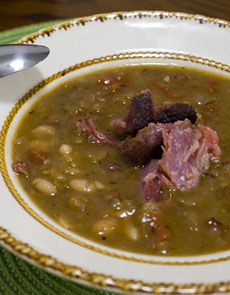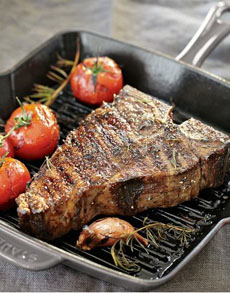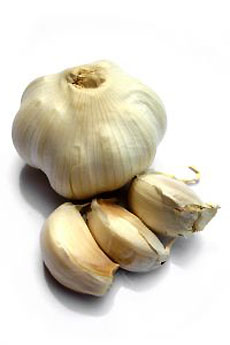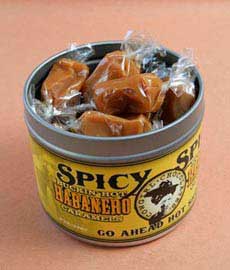|
Today’s gift recommendation is a line of fine loose teas in decorative caddies*, from a renowned French firm, Le Palais des Thés (luh pah-LAY day tay, “The Tea Palace”).
The company was founded in 1986 by a group of French tea enthusiasts, who went into the tea business so they could have the freshest, highest-quality teas. In handsome packaging, the teas are sold worldwide.
But before we dig in to the tea gifts, here’s a bit of tea history. (Don’t want history? Scroll down.)
A Brief History Of Tea-Drinking In Europe
England is known for tea-drinking; but it actually came late to the game. Tea was first introduced to Europe via Portugal.
*A tea caddy is a small box, can, or chest for holding tea leaves.
|
|
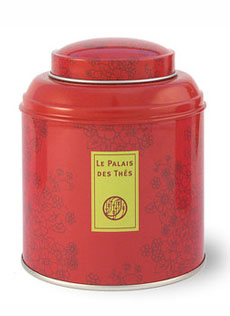
The des Songes, an oolong tea, in a
festive red caddy. Photos courtesy Le Palais Des Thés. |
Portuguese traders visiting Asia brought tea back from China and Japan in the late 1500s. Tea was instantly popular among the Portuguese nobility, who had the means to buy the new luxury. Tea was served daily at 5:00 p.m., still a Portuguese tradition.
The Portuguese infanta, Catherine of Braganza, married to England’s King Charles II in 1662, introduced† the custom of drinking tea to England.
Tea was extremely costly for more than 100 years, due to rarity and taxes. It was kept in a locked chest to prevent pinching by servants and others. But after the 1750s, smuggled tea was widely available, reasonably-priced and purchased by respectable people.
†Catherine also introduced the fork to the England. Amazingly, although it was used by the ancient Greeks and Romans, and the Roman legions occupied England, the fork took many centuries to make the leap.
|
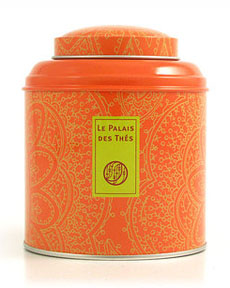
Thé des Moines, or Monks’ tea, is a blend of green and black teas created in a Tibetan monastery. |
|
In the 17th century, tea caddies were made from enameled metal, glass, porcelain and silver. From about 1725, in England, they began to be made of mahogany. Shaped like small chests, caddies held three metal canisters for tea. They became a home accessory: A genteel household had to have one.
According to A Brief History Of Tea And Tea Caddies, the word caddy derives from the Malay kati, a measure of weight equal to about 3/5 of a kilo.
And now, for your consideration, some delicious teas in lovely caddies:
Le Palais De The: Gift Canisters Of Fine Tea
Fleur De Geisha. Inspired by the Japanese tradition of viewing the flowering cherry trees, Fleur de Geisha is an elegant Japanese green tea, delicately flavored with cherry blossoms. More information.
|
|
Thé Des Alizés. Alizés means “trade winds.” Here the trade winds bring a lovely green tea, flavored with white peach, kiwi and watermelon and enhanced with flower petals. More information.
Thé Du Hammam. A flowery green tea infused with berries, green date, orange flower water and rose petals, in a pale blue caddie. A hammam is a luxurious Turkish bath house. The blend evokes the fragrances used to perfume the hamman. More information.
Thé Des Lordes. The French term for Earl Grey Tea. The tea has a bergamot scent and flavor, with a visual addition of bright orange safflower petals. Charles Grey, 2nd Earl of Falloden and Foreign Secretary, received the gift of this specially scented and flavored tea for saving the life of the Chinese Mandarin. The earl became Prime Minister in 1830. More information.
Thé Des Moines. “Monk’s tea” is a blend of black and green teas, based on a recipe made by Tibetan monks. More information.
Thé Des Songes. This “tea of dreams” is a delicious oolong tea scented with flowers and exotic fruits. More information.
Thé Des Vahines Rooibos. Caffeine-free rooibos (roy-boss) tea is flavored with with vanilla and almond. A delicious dessert tea. Vahine is the Tahitian word for woman. More information.
A canister (caddy), 4.4 ounces, is $25.00.
|
|
